It detaches from the ground and rises vertically over the city like a helicopter. PopUp, the electric vehicle prototype developed by Italdesign in collaboration with Airbus, was designed to travel on the road and fly. But the promise of sustainable mobility does not end there: the experience must be unique, like each of the users. The different interfaces, hypothesized by the Polytechnic of Turin, exploit the interaction, transforming themselves into an enhancement of their own personal devicein an augmented workstation and connection, in augmented reality able to interact with the context.
Each interface is capable of generating new services and, above all, new connected behaviors. Behaviors that are at the heart of the behavioural design, an approach that is widely used for products and services based on sustainability. “The behavioural design it is widespread in contexts where lifestyles are planned, solutions are sought in the food, mobility and automotive, health sectors. In short, in all those areas in which there is an environmental and social impact “explains Pier Paolo Peruccio, professor of Design at the Polytechnic of Turin and member of the World Design Organization, a non-profit organization which is a consultative body of the United Nations and offers its contribution on how design can contribute to the Sustainable Development Goals of the 2030 Agenda.
What is behavioral design
The behavioural designbranch of the behavioural science, is a field of study that integrates different disciplines, from design to economics, from psychology to information technology. But the link between the environment and behavioural science it’s not new. In the 1960s, the planet Earth was represented as a spaceship and Spaceship Earth became the metaphor for expressing the limits of resources. Metaphor, recalls Peruccio, taken up in 2007 by David Houle (“The shift age”) to send a message to the inhabitants of the planet: we must act not as passengers but as flight attendants who take care of the spaceship. This new era of change will be driven by awareness. Awareness that every choice has consequences for us and the environment. And, remembers Peruccio, awareness of the project, “projected»Which derives from Latin«projection», Or« to launch forward », to have an idea of the future. Which concerns the change you want to stimulate. It is no coincidence that the first national master’s degree in behavioural design will have a home in Ivrea, as part of Ico Valley, an industrial project that aims to create a digital lab on the challenges of digital transition and sustainability.
The roots in the Canavese area
“The academy wants to collect the cultural heritage of the Interaction Design Institute, where the Arduino project was born, and feeds on the whole thought of Adriano Olivetti who conceived businesses not only as places of production but as engines of cultural growth of the territory, modifying the behavior of employees and inhabitants “says Peruccio who will be coordinator of the second level master” Behavioral Design. Systems, Interactions and Strategies for Digital »curated by the Turin Polytechnic – which has been exploring sustainability issues within systemic design for twenty years – in collaboration with the University of Turin and Confindustria Canavese. The guiding discipline of the path, which has the support of players such as Huawei and Tim, will be theinteraction design, where the interaction is comparable to a behavior because it involves reciprocal actions of two interlocutors in a context. Context that must be designed correctly and appropriately with an ethical component and therefore a sense of collective responsibility.
How are behaviors addressed?
First of all, we move from a merely sanctioning, punitive logic to a logic that rewards. «For example, in addition to sanctioning the wrong drivers, why not reward the virtuous ones? The game dynamics are used a lot through which people are motivated to participate, we want to increase theengagement, the desire to get involved »adds Peruccio. Thus, in the smart district Uptown in Milan, the analysis of data on lifestyles and interviews with people led to a “Manual for living in a smart district” in which infographics illustrate the consequences, for example, of different types of waste disposal and composting becomes an opportunity to encourage the participation of all and to talk about natural cycles and nutrition involving the inhabitants. Or again in the concept developed for the Italian Blind Union, the interaction understood as gestures for the benefit of blind or visually impaired children was enhanced: the smartphone keyboard was equipped with intelligent materials capable of perceiving the touch, with the temperature and the different textures, some gestures coded to convey one’s emotions to the other person.
